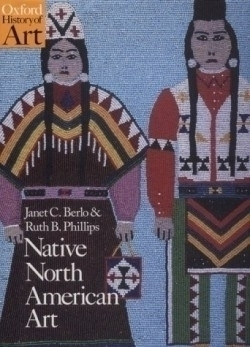Native North American Art
Between 1879 and 1885, the Smithsonian Institute collected over 6,500 pottery vessels made by the women of two Pueblo villages made up of only a few hundred inhabitants each.
ar·te·fact 1. An object produced or shaped by human workmanship; especially, a simple tool, weapon or ornament of archaeological interest. The American Heritage Dictionary
Adeline Wanatee describes a Mesquakie ribbon-work blanket: “When two different patterns join together to form a third, we call that ‘art.’”
Berlo and Phillips also call it “art” and define their terms in the introduction: “… an object whose form is elaborated to provide visual and tactile pleasure and to enhance its rhetorical power as a visual representation.” But it is the gulf of misrepresentation, misconception and mistreatment between Native Americans and Westerners that moves this outstanding new volume in the Oxford History of Art series. Designed to introduce readers to the depth and diversity of Native regional art, it is also a highly readable introduction to Native North American history and anthropology.
The book is divided into geographical sections and often tells a story-of the persistence of cultures hounded by disease, death and destruction. Non-Native patronage, tourism and authenticity are all topics that are thoughtfully discussed, resurfacing again and again, according to the region, but always at a new depth, or from a different angle. Nationality, Native symbolism and the Warrior in the European imagination are other reoccurring themes. Each section is chronological, but the authors regularly suspend the timeline in order to introduce examples of contemporary art and artists. Be sure to take good notes, for although the Bibliographic Essay is a tour-de-force, the index is thin.
The final section is titled “The Twentieth Century: Trends in Modern Native Art” and the authors are convincing in their assertion that “The work of contemporary artists, crossing gender boundaries and making use of concepts and media from Western art, has come to equal or even surpass that of their illustrious forebears.”
Reviewed by
H. Shaw Cauchy
Disclosure: This article is not an endorsement, but a review. The publisher of this book provided free copies of the book to have their book reviewed by a professional reviewer. No fee was paid by the publisher for this review. Foreword Reviews only recommends books that we love. Foreword Magazine, Inc. is disclosing this in accordance with the Federal Trade Commission’s 16 CFR, Part 255.

